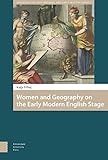Women and Geography on the Early Modern English Stage / Katja Pilhuj.
Material type: TextSeries: Gendering the Late Medieval and Early Modern World ; 9Publisher: Amsterdam : Amsterdam University Press, [2019]Copyright date: ©2019Description: 1 online resource (276 p.)Content type:
TextSeries: Gendering the Late Medieval and Early Modern World ; 9Publisher: Amsterdam : Amsterdam University Press, [2019]Copyright date: ©2019Description: 1 online resource (276 p.)Content type: - 9789048544226
- Cartography in literature -- History -- Early modern, 1500-1700
- Theater -- History -- Early modern, 1500-1700 -- England
- Women in literature -- History -- Early modern, 1500-1700
- AUP Wetenschappelijk
- Amsterdam University Press
- Early Modern Studies
- Gender and Sexuality Studies
- History, Art History, and Archaeology
- Literary Theory, Criticism, and History
- LITERARY CRITICISM / Drama
- Geography, Renaissance drama, women, representation
- 822.052 23/eng/20230216
- online - DeGruyter
| Item type | Current library | Call number | URL | Status | Notes | Barcode | |
|---|---|---|---|---|---|---|---|
 eBook
eBook
|
Biblioteca "Angelicum" Pont. Univ. S.Tommaso d'Aquino Nuvola online | online - DeGruyter (Browse shelf(Opens below)) | Online access | Not for loan (Accesso limitato) | Accesso per gli utenti autorizzati / Access for authorized users | (dgr)9789048544226 |
Frontmatter -- Table of Contents -- List of Figures -- Acknowledgments -- Introduction -- 1. Confuting Those Blind Geographers -- 2. ‘T’illumine the now obscurèd Palestine’ -- 3. ‘Willing to Pay Their Maidenheads’ -- 4. ‘The Fort of her Chastity’ -- Conclusion -- Bibliography -- Index
restricted access online access with authorization star
http://purl.org/coar/access_right/c_16ec
In a late 1590s atlas proof from cartographer John Speed, Queen Elizabeth appears, crowned and brandishing a ruler as the map's scale-of-miles. Not just a map key, the queen's depiction here presents her as a powerful arbiter of measurement in her kingdom. For Speed, the queen was a formidable female presence, authoritative, ready to measure any place or person. The atlas, finished during James' reign, later omitted her picture. But this disappearance did not mean Elizabeth vanished entirely; her image and her connection to geography appear in multiple plays and maps. Elizabeth becomes, like the ruler she holds, an instrument applied and adapted. Women and Geography on the Early Modern English Stage explores the ways in which mapmakers, playwrights, and audiences in early modern England could, following their queen's example, use the ideas of geography, or 'world-writing', to reshape the symbolic import of the female body and territory to create new identities. The book demonstrates how early modern mapmakers and dramatists -- men and women -- conceived of and constructed identities within a discourse of fluid ideas about space and gender.
Mode of access: Internet via World Wide Web.
In English.
Description based on online resource; title from PDF title page (publisher's Web site, viewed 25. Jun 2024)


